National Planning Framework 3
The third National Planning Framework, setting out a long-term vision for development and investment across Scotland over the next 20 to 30 years.
2. A successful, sustainable place
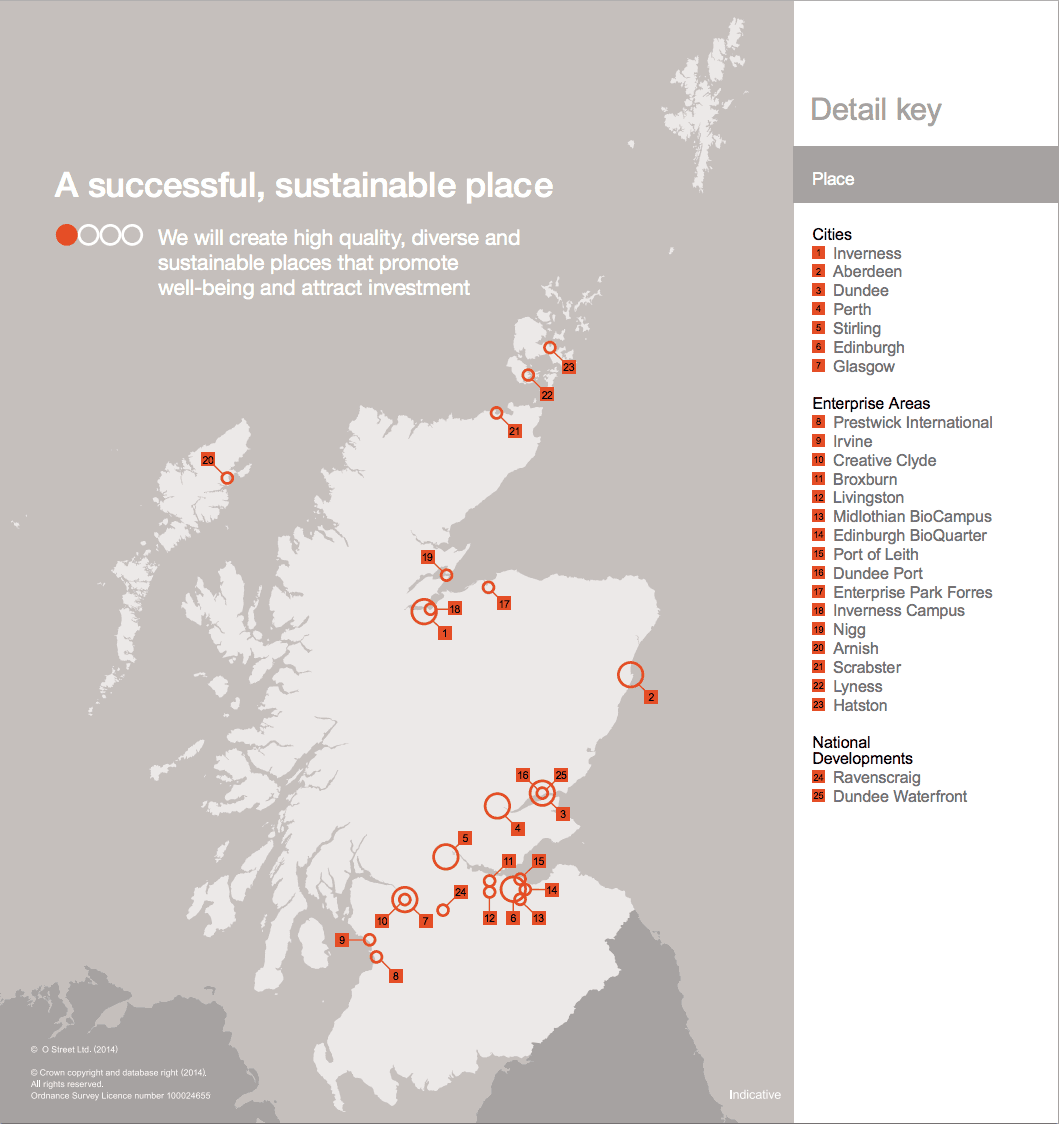
We will create high quality, diverse and sustainable places that promote well-being and attract investment.
Scotland today
2.1 Scotland has the highest level of Gross Value Added ( GVA) per head in the UK outside of London and the South East of England, and productivity levels match the UK as a whole. Whilst the recession in Scotland has been shallower than that experienced elsewhere in the UK, economic recovery is expected to continue through the 5-year lifetime of NPF3.
2.2 We want to build on our success. The Scottish Government Economic Strategy aims to stimulate economic activity and investment across all of Scotland's communities. It sets out the action we are taking to accelerate economic recovery and provide jobs and identifies seven key sectors with particular opportunities for growth. These opportunities arise from existing competitive advantage and the potential to capitalise on our natural assets. Our key sectors are: energy; food and drink; life sciences; tourism; financial and business services; universities and the creative industries.
2.3 Employment levels and community resilience vary across Scotland. Fragile places can be found not only in remote areas, but also close to and within some of our towns and cities. The Scottish Government is committed to reducing the gap between those who are most and least advantaged in society, and this has a spatial dimension. Our Cohesion Target aims to narrow the gap in economic participation between the best and worst performing regions by 2017.
2.4 All of our people are entitled to a good quality living environment. The population of Scotland is expected to rise from 5.31 million in 2012 to 5.78 million in 2037. The population is ageing, particularly in rural areas and household sizes are getting smaller: 2010-based projections indicate that we will have 2.89 million households by 2035, an increase of 23%. Growth is projected to be highest in the local authority areas of Edinburgh, Perth and Kinross, Aberdeen, East Lothian and Aberdeenshire. In other areas, including some in the west, the increases are much smaller, although Glasgow itself is projected to grow by 28%. These contrasts between areas reflect very different circumstances around the country.

2.5 The financial climate has reduced the amount of new housing built in recent years. In the coming years, we want to see a significant increase in house building to ensure housing requirements are met across the country.
Scotland tomorrow
2.6 Our strategy aims to ensure that all parts of Scotland make best use of their assets to build a sustainable future. Planning will help to create high quality, diverse and sustainable places that promote well-being and attract investment.
2.7 Great places support vibrant, empowered communities, and attract and retain a skilled workforce. Emerging technologies for renewable energy and improved digital connectivity are changing our understanding of what constitutes a sustainable community. We must ensure that development facilitates adaptation to climate change, reduces resource consumption and lowers greenhouse gas emissions.
2.8 We will support growth in priority sectors and locations, and promote a place-based approach to development. We want to capitalise on the distinctive potential of each of our cities as economic drivers, reinvigorate our towns and encourage innovation in our rural areas. Much can be gained by focusing on our energy resources; on the natural and cultural assets that underpin our tourism and food and drink sectors; on our highly educated and skilled people; on our emerging growth sectors including life sciences and creative industries; on our established strengths in financial services and higher education; and on our existing infrastructure in the transport, energy and industrial sectors.
2.9 We need to close the gap between our best- and worst-performing regions. To address long-standing problems of inequity we will need new solutions that reflect the distinctive character of all our places.
2.10 Flexibility is required to allow for different approaches to housing provision that respond to varying local requirements. Planning should focus its efforts particularly on areas where the greatest levels of change are expected and where there is pressure for development.

2.11 Our Enterprise Areas are a particular priority for action. Successful places can emerge from areas which have, in the past, seen decline. Scotland's Regeneration Strategy promotes community-led regeneration with a particular emphasis on the economic, physical and social fabric of disadvantaged communities. The Scottish Futures Trust is helping to make more efficient use of public assets to improve the quality of places. Legislation on community empowerment will strengthen opportunities for communities to have their voices heard in decisions that affect them and their local area, as well as scope to take ownership of and manage properties to support their aspirations. The Town Centre Action Plan will help us to realise the full potential of our many and varied towns.
Spatial priorities for change
Cities will be a focus for investment
2.12 Scotland's seven distinctive cities, together with their surrounding regions, will continue to be a focus for investment in the coming years. Our spatial strategy recognises the strengths which are shared across the city regions, as well as the distinctive assets of each. Each city's relationship with its surrounding region is unique.
2.13 Cities are the main driver of our economy - notably the performance of Aberdeen and Edinburgh exceeds what may be expected from their population size. All of the seven key sectors in our economic strategy have a strong presence in the cities, in particular the creative industries, financial and business services, learning and life sciences. Many of our Enterprise Areas are located in and around our cities.
2.14 There is considerable scope for our cities to capitalise on new and growing economic sectors. The cities and their wider regions host many of the sites identified in the National Renewables Infrastructure Plan, and other key economic development sites, for example those near our main airports. There are a number of sites within the cities network where there is scope to make use of our cool climate, skills, and fibre network to attract investment in data centres. The Scottish Cities Alliance has prepared City Investment Plans showing the key investment and development opportunities in each city.

2.15 City centres are key assets for attracting investment and providing services. Quality of place is fundamental to the success of our cities, in particular city centres. We wish to see ambitious, up-to-date frameworks for city centre development. These should focus on the quality, sustainability and resilience of the built environment and wider public realm, and on improving accessibility by public and sustainable transport modes, such as cycling.
2.16 Reducing the impact of the car on city and town centres will make a significant contribution to realising their potential as sustainable places to live and invest by addressing congestion, air pollution and noise and improving the public realm. Significant health benefits could be achieved by substantially increasing active travel within our most densely populated areas.
2.17 The cities are, of course, at the core of their regions, but the towns within these regions are also important centres where many people live and work. Many of these towns are crucial transport, commercial and cultural hubs. The Town Centres Review called for a 'town centres first' approach to planning policy. The Scottish Planning Policy responds to that objective and the Town Centre Action Plan reflects a further call to expand this beyond planning policy to a principle which drives public sector investment decisions. We are committed to working with COSLA and other partners to determine how this principle will work in practice.
2.18 In some parts of the cities network, population decline is expected, whilst in other places there is projected growth. Some cities have greater pressure for additional housing development. In some, regeneration remains a priority. But throughout, there will be a need to ensure a generous supply of housing land in sustainable places where people want to live, providing enough homes and supporting economic growth.
2.19 In some of our city regions, infrastructure capacity is limiting the delivery of new housing and other development. We expect to see more concerted efforts - involving planning authorities, developers, government agencies and infrastructure providers - to remove these constraints. Solutions could include new infrastructure provision in some cases, but more viable and sustainable options are likely to make best use of existing infrastructure and service capacity. Strategic thinking, partnership working and innovation will be required to unlock funding for capacity enhancement. Housing requirements will continue to be at their most acute around Edinburgh, Perth and Aberdeen - requiring targeted action to better match demand for land with infrastructure capacity.

2.20 Further increasing the density of development, particularly in the centre of towns and cities and in key locations which are well-served by public transport, could accommodate much of this growth. However, more ambitious and imaginative planning will be needed to meet requirements for a generous and effective supply of land for housing in a sustainable way. Planning can ensure it enhances quality of life through good placemaking, and lead a move towards new, lower carbon models of urban living. More empowered communities have a key role to play in this. Our programme of town centre charrettes will demonstrate how significant change can be achieved through a design-led and collaborative approach.
2.21 Most of Scotland's vacant and derelict land lies in and around our cities, and particularly in west central Scotland. This presents a significant challenge, yet also an opportunity for investment. Planning has an important role to play in finding new and beneficial uses for previously used land including, in the right circumstances, 'green' end uses. A planned approach will continue to deliver development in the parts of our city regions where there is a continuing need for regeneration.
2.22 The challenges and opportunities vary across the country. The longstanding proposals at Ravenscraig to bring one of Europe's largest areas of previously developed land back into use will benefit from additional impetus of national development status to secure further investment. The redevelopment of the Dundee Waterfront, also a national development, demonstrates the way in which planning can effectively deliver large-scale transformation.
A flexible strategy for diverse places - distinctive city regions
2.23 This is a national strategy with a shared vision for Scotland, but it will be applied in different ways in each of our seven cities. The following section demonstrates the diverse and distinctive opportunities for Scotland's city regions to develop as successful, sustainable places.
Glasgow and the Clyde Valley
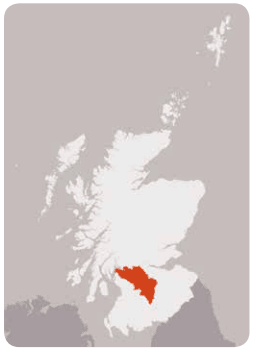
The Glasgow region encompasses, North and South Lanarkshire, East and West Dunbartonshire, Renfrewshire, East Renfrewshire and Inverclyde, and is home to around a third of Scotland's population.
The area is Scotland's biggest economic region. There are opportunities to develop each of our seven key economic sectors in the region, and there are particular strengths in energy, financial services, universities, life sciences and tourism. Glasgow is aiming to be widely recognised as an exemplary Green City. Building on its economic strategy, the city is working with its neighbouring local authorities to develop proposals for a city deal to drive employment and economic development across the city region.
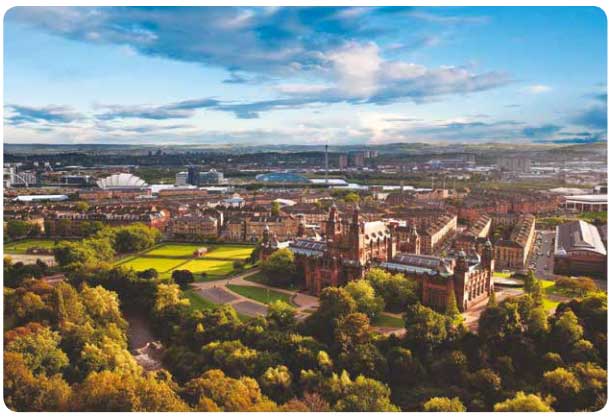
The city region has ambitious plans for growth in a development corridor extending through the city and along the Clyde. The Creative Clyde Enterprise Area reflects the importance of this sector for the city region and supports the development of a new, vibrant digital quarter on the Clyde waterfront. Glasgow city centre is the key economic asset for the region, and contains a number of significant opportunities for investment, most notably its waterfront area. The City of Glasgow College development and new South Glasgow Hospital will be completed in 2015. Much development will be focused on the city centre, in the key regeneration areas and at a number of Community Growth Areas around the city region.
Regeneration is the central focus of planning across this city region. Partnership working is driving consolidation and renewal of the built environment, embedding future growth within a distinctive placemaking agenda. The Urban Regeneration Companies at Clyde Gateway, Clydebank and Riverside Inverclyde are continuing to transform some of Scotland's most extensive post-industrial areas. It is essential that we build on the success already achieved to address nationally significant and longstanding issues of disadvantage.
Facilities for the 2014 Commonwealth Games are in place and the focus over the coming years will be on building a legacy for all of Scotland. As a key part of this, there has already been excellent progress in the regeneration of the Clyde Gateway, an ambitious transformational project where there has been outstanding progress to date. We are confident that the long-term vision for regeneration in this area, delivered through partnership working and involving local people, agencies and developers, provides a strong foundation to attract investment. In the next five years and beyond, this initiative will create a vibrant place that benefits communities and investors alike.
Other longstanding regeneration priorities will require further impetus to secure delivery. The masterplanned development of Ravenscraig, a national development, will transform one of Europe's largest areas of vacant and derelict land into a new, sustainable community.
New opportunities continue to emerge. The Strathleven area has significant potential for growth and regeneration and there are proposals for a Simplified Planning Zone at Hillington. The work of the Glasgow Canals Partnership to drive forward regeneration along the Forth and Clyde Canal corridor demonstrates the scope to secure investment that transforms the quality of the environment for communities across the city and the wider Central Belt.
Integral to the delivery of these infrastructure and regeneration projects will be the Central Scotland Green Network - improving quality of place, addressing environmental inequalities and enhancing health and well-being. Alongside this, the Metropolitan Glasgow Strategic Drainage Partnership is improving the quality of the water environment in the Glasgow area and facilitating growth and regeneration. Sustainable infrastructure networks will form the foundations of regeneration and development and build resilience to climate change. There is significant scope for district heating in the north of the city and in the central Glasgow area.
The relationship between Glasgow and its surrounding communities is crucial. Considerable progress is being made in transforming many of the towns across the region. Whilst sharing the common driver of adapting to economic change, these towns are finding distinctive solutions which reflect each of their unique qualities, whilst working together to contribute to the wider cities agenda. Initiatives range from using Paisley's distinctive street pattern and historic buildings to create a 21st-century town centre, to revisiting the role of Cumbernauld's town centre to better reflect today's lifestyles.
Connectivity is key to the success of the region, with High Speed Rail between Glasgow and Edinburgh, and in time on to London, aimed at making the Central Belt a stronger and more unified economic region in European terms. Improvements to the regional rail network, including links to Ayrshire and Inverclyde, are progressing through a £430 million investment over 16 years. The gateway role of Glasgow and Prestwick Airports, and the growth of their associated economic investment zones including the Prestwick International Aerospace Park Enterprise Area, will bring economic and connectivity benefits. Continuing work to improve surface access to Glasgow Airport has been informed by the Glasgow Airport Strategic Transport Appraisal and forthcoming review of the Airport Surface Access Strategy.

Edinburgh and the south east
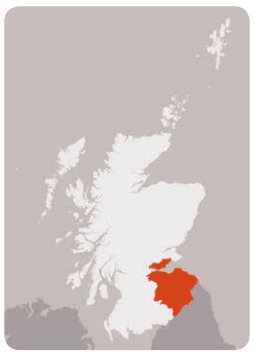
Edinburgh is Scotland's capital city, and the south east of the country supports many of our most important economic assets - and many more future opportunities. The city region includes West Lothian, Midlothian and East Lothian, extends north into Fife and south into the Scottish Borders.
Edinburgh is one of Europe's most important centres for financial services and tourism, and the world's foremost festival city. Energy will be an increasingly important sector, centred on the city and at sites around the Forth. Life sciences will also see growth, in particular in clusters linked to universities. Creative industries, universities and food and drink all have a strong presence in the city region, and good prospects for growth.
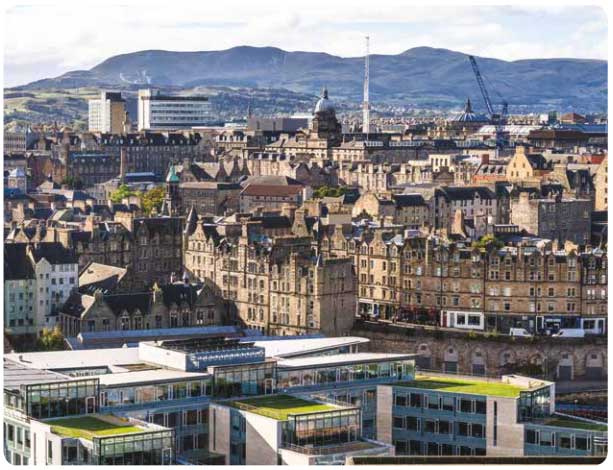
The City of Edinburgh Council's Economic Strategy sets out a vision for Edinburgh to be "a confident, creative and inspiring capital city, powering growth and providing jobs for the city region and Scotland. A city whose quality of life and commitment to sustainability draws talent and investment from around the world where the public, private and third sectors collaborate with common purpose."
As with Glasgow, Edinburgh will benefit from unifying projects across the Central Belt including High Speed Rail and the Central Scotland Green Network. Enhancement of the gateway role of Edinburgh Airport will bring economic and connectivity benefits, as will new freight capacity on the Forth. Within the city, efforts to promote active travel are being taken forward, providing health and environmental benefits. Southwards, the Borders Railway will provide a new sustainable transport connection from the city to the Scottish Borders, whilst the A1 provides an essential cross-border link. The completion of the Queensferry Crossing, the Forth Replacement Crossing which was included as a national development in NPF2, will further strengthen connectivity along Scotland's east coast economic corridor.
The SESPlan area is projected to have the second largest rate of growth of the four SDPAs - a 20% increase in population and 32% increase in households between 2010 and 2035. A planned approach is required to ensure development needs are met, whilst taking into account existing and future infrastructure capacity. Led by SESplan, we wish to see greater and more concerted effort to deliver a generous supply of housing land in this area.
Whilst programmed transport improvements will collectively go some way towards enhancing capacity for growth, the longer-term spatial strategy for delivering housing land will need to acknowledge and address the region's infrastructure constraints. To help unlock effective housing land in the city-region, strategic, cross-boundary transport infrastructure improvements are required. Securing funding for these projects will be crucial to realise the region's potential for growth. Road network capacity, including the A720 where interventions are being taken forward at Sherriffhall Roundabout, has particular implications for future development.
Within Edinburgh, the city centre, the waterfront, West Edinburgh and South East Edinburgh will be a focus for growth. The city centre is the civic, cultural, tourism and commercial hub, with its world-renowned built heritage as a key asset. The waterfront is a priority for regeneration, new homes and port, energy and industrial development. West Edinburgh is a significant location for investment, with the airport, the National Showground and the International Business Gateway. Development here will require continued co-ordination and planning to achieve a successful business-led city extension which fulfils its potential for international investment, new jobs and high quality of place. Further south, the National Performance Centre for Sport at Heriot Watt University will open in 2016. There are existing district heat networks in central Edinburgh and potential for these to expand in areas of development.
South East Edinburgh, and into Midlothian, will accommodate significant growth and is a key location for life sciences based around the Edinburgh BioQuarter and nearby Midlothian BioCampus. Both are part of a national Life Sciences Enterprise Area, whilst the Low Carbon/Renewables East Enterprise Area includes Leith Port. North and west of the city, Glenrothes, Kirkcaldy, Dunfermline and Livingston are important hubs for employment and services, and strategic growth areas are identified across the region. In West Lothian, key economic initiatives include the Heartlands development, where a new junction has been opened on the M8, and the Enterprise Areas at Broxburn and Livingston. The Fife Energy Corridor, which extends from Methil to Longannet, has potential for significant investment in energy-related business development, as do the Cockenzie and Torness areas in East Lothian.
As well as growth, regeneration remains a priority in some parts of the city region. PARC, an Urban Regeneration Company, continues to work to regenerate the Craigmillar area of Edinburgh. Work is also ongoing at several locations around the city and in other towns, in particular the coalfield areas.
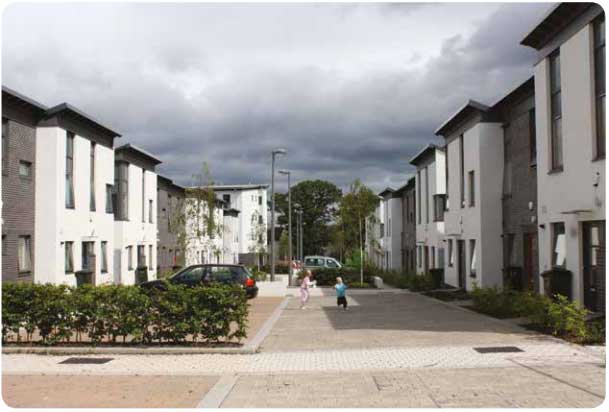
Stirling
Stirling is the historic city at the heart of Scotland. Energy, food and drink, financial and public services, and tourism are among the key economic sectors, and the city is a nationally important centre for sport. The Loch Lomond and The Trossachs National Park is a short journey away. Stirling also has close links with surrounding areas, including Falkirk, Clackmannanshire and into west Fife.
Stirling's city vision is to be a location of choice with a vibrant and growing economy, a place with jobs and opportunities for all, providing a high quality of life for residents and visitors.
Planning in Stirling focuses on both regeneration and sustainable growth, for the city itself and the nearby towns and villages. Its central, well-connected location, outstanding built heritage and thriving university campus make it ideally positioned to attract investment.
The city centre is a key focus for that investment, with the City Investment Plan emphasising its role as a focal point for business activity, tourism and city centre living. Infrastructure investment priorities include improving digital connectivity and transport links, and enhancing the quality and availability of business premises.
The Forthside area is also a priority for mixed development, including the new National Conservation Centre, and there is potential for the Stirling University Innovation Park to be extended. Continued regeneration, in particular at Raploch and the Eastern Villages, will remain a priority, as will tackling flood risk issues. There are plans for growth and regeneration in several locations outwith the city, including a new settlement proposed at Durieshill and at a number of strategic development areas.
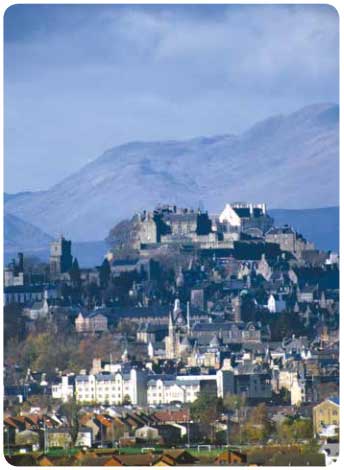
Perth
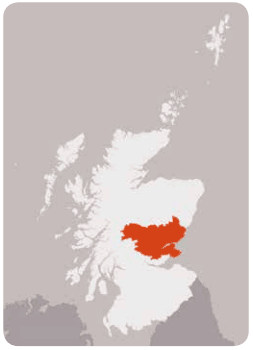
Perth is Scotland's newest city and a strategically important gateway to the north and north east of the country. Along with Dundee, it sits within a wider region with scenic countryside and towns.
Perth's central location within Scotland's road and rail network makes it ideally placed to attract investment, as does its high quality of life with a strong cultural scene in and around the city and a range of outdoor activities on its doorstep. Key tourism assets include the towns and countryside in Perthshire and Angus, extending into the Cairngorms National Park. Gleneagles, located close to Perth, is the venue for the 2014 Ryder Cup.
The City Investment Plan sets out a vision to develop Perth into the most desirable place in Scotland to live, work, visit and invest. The city centre will be a focus for investment, as will strategic growth areas identified at west and north west Perth and at Oudenarde. These, together with a number of strategic growth areas in Dundee, Angus and north Fife, will provide a focus for most new housing and business development.
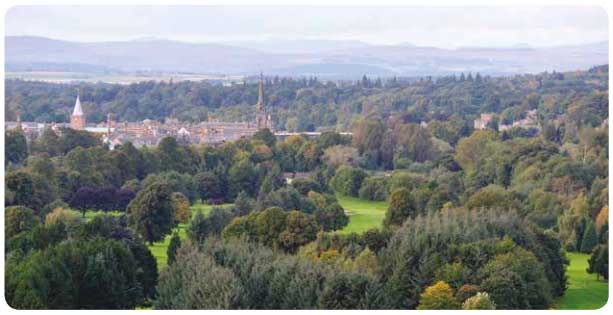
Dundee and Tayside
Dundee is undergoing transformational change, led by over £1 billion of investment in the regeneration of its waterfront. Along with Perth, it sits within a wider city region with high quality countryside and distinctive towns. The Dundee city region extends northwards into Angus and southwards into Fife.
The City Investment Plan vision is for "Dundee to be an internationally recognised city at the heart of a vibrant region with more and better employment opportunities for our people." Priorities include growing businesses and sectors, employability and skills, improving physical infrastructure, place marketing and tourism promotion.
Dundee is an established and growing centre for creative industries (particularly video- gaming), for universities, life sciences and for high-tech manufacturing. Energy will become an increasingly important sector, with opportunities at Dundee Port which is part of the Low Carbon/Renewables East Enterprise Area, and elsewhere on the coast, including at Montrose. Key tourism assets include the towns and countryside in Perthshire and Angus, extending into the Cairngorms National Park, and into Fife where St Andrews is a focus for visitors.
The redevelopment of Dundee Waterfront encompasses 240 acres along 8km of the River Tay, in five distinctive areas - Central Waterfront, Seabraes, City Quay, Dundee Energy Parks and the Port of Dundee. This project includes the V&A at Dundee, improvements to the railway station and port and industrial development. It is facilitating growth and regeneration in the city and the wider region. As part of this, significant improvements to the public realm will strengthen the city's appeal to investors and reinforce civic identity.
A strategic approach to green infrastructure will help to achieve sustainable development patterns and contribute to placemaking in and around the city. Transport connections to the rest of the cities network will continue to be a priority. In the longer term, there is a need to finalise the best approach to upgrading the A90 through Dundee, either by improving the existing road or on a new alignment by-passing the city.
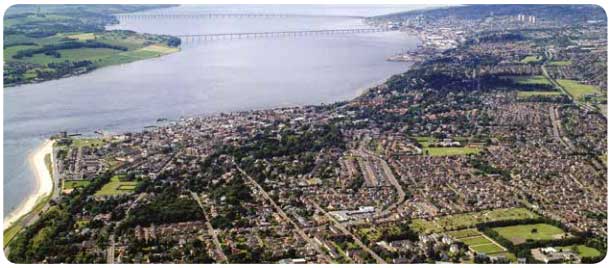
Aberdeen and the north east
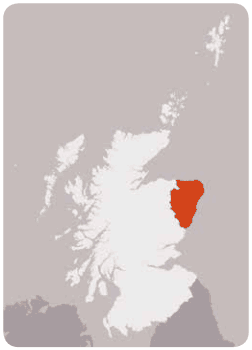
Aberdeen is the energy capital of Europe. The north east of Scotland has above-average incomes, low unemployment and a high quality of life. The area's exceptional economic performance provides a real opportunity to build on its success and benefit Scotland as a whole. The City Investment Plan sets out an ambition "to maintain Aberdeen's position as one of the world's key energy capitals and to maximize its growth potential and diversification into other sectors." Infrastructure provision is a key part of this agenda for growth and investment.
Aberdeen and its wider city region is well-placed to take advantage of continued exploitation of North Sea oil and gas reserves and to develop its expertise in serving this sector, and the growing renewable energy sector around the world. Opportunities from oil and gas reserves West of Shetland, from decommissioning existing infrastructure and from the deployment of offshore renewables will become increasingly important. Food and drink, life sciences, universities, creative industries and tourism are among the other key sectors for this city region.
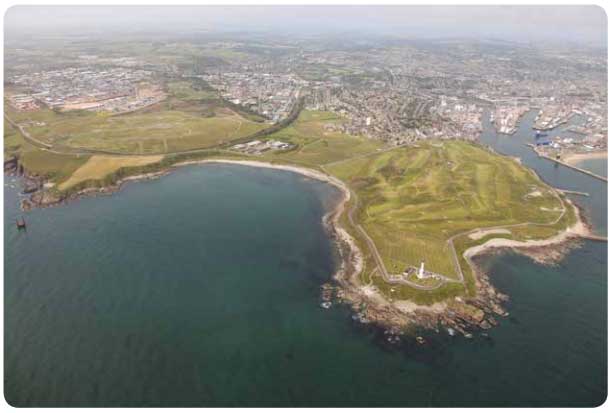
The expansion of Aberdeen Harbour will strengthen its key role in supporting the economy of the north east, as too will continued improvements to infrastructure including the Aberdeen Western Peripheral Route and Aberdeen Airport. The economic significance of the region is recognised through the need for infrastructure capacity enhancement, both within the city region and in terms of wider links. Beyond the opening of the Aberdeen Western Peripheral Route by 2018, the Infrastructure Investment Plan commitment to improving rail links from Aberdeen to the Central Belt by 2030 will be progressed in phases with improvements being seen by 2019, as well as progress in the planning for removing single track sections around Montrose. £170 million of improvements to the Aberdeen to Inverness railway including improvements between Aberdeen and Inverurie will be in place by 2019 and work is underway to dual the A96 by 2030.
Development of Carbon Capture and Storage technology focussed on Peterhead, and possibly St Fergus, enhancements to the electricity grid and new connections for offshore renewables underline the importance of energy-related development to this region, as does the planned European Offshore Wind Deployment Centre off the coast of Aberdeen. There is a growing district heat network in the centre of the city.
The city region extends from the city into wider Aberdeenshire. The area has the greatest projected population growth of Scotland's four strategic development plan areas (23%), with a 35% increase in households between 2010 and 2035. Much of the new housing development in the city region will be in a number of strategic growth areas in the city and in corridors extending from it - northwards to Peterhead, north west to Huntly and southwards to Laurencekirk. Affordable housing will continue to be a strategic priority in the North East given the wider context provided by the buoyant private housing market in the region. The focus of regeneration efforts will be in the city centre, other parts of the city, and in some coastal communities - most notably Peterhead and Fraserburgh. The city, and the whole region, will benefit from improved conference facilities.
There are particular opportunities in the 'Energetica' corridor from Aberdeen northwards towards Peterhead, where a key hub for energy infrastructure and related development is envisaged. There will be benefits to taking a co-ordinated approach to planning for this and related development in the wider Peterhead area.
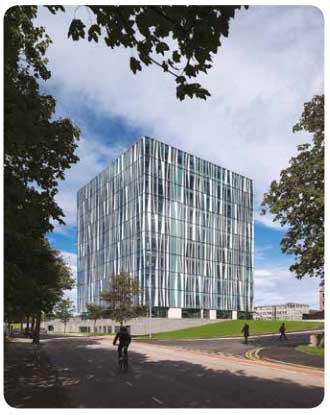
Inverness and the Inner Moray Firth
Inverness is the capital of the Highlands - the fastest-growing city in Scotland, serving the whole region and acting as a gateway to the Highlands and Islands. The City Investment Plan envisages Inverness as "a can-do place where individuals, communities and businesses are able to realise their full potential and fulfil ambitions that benefit them, their city and the wider region."
Key economic sectors include energy, tourism and life sciences. Better surface access to Inverness Airport, with the dualling of the A96 and a new rail station at Dalcross, will bring economic and connectivity benefits. The University of the Highlands and Islands is centred at the new £100 million Inverness Campus, and life sciences are a particular focus here and in the A96 corridor, with the Forres Enterprise Park forming part of a Life Sciences Enterprise Area. Financial services are becoming ever more important to the area's economy.
Inverness city centre is the administrative, transport, services and tourist hub for the region. Further hotel accommodation will strengthen this. The city is expanding to the west, south and, in particular, to the east, with growth along the A96 Corridor to Moray, including development of a new settlement at Tornagrain. A further growth corridor extends from Muir of Ord and the Black Isle north eastwards through to Tain and Nigg. Regeneration is a priority at a number of locations in Inverness, including at the Muirtown Basin and at Longman. Making more use of the harbour and Caledonian Canal can bring particular benefits.
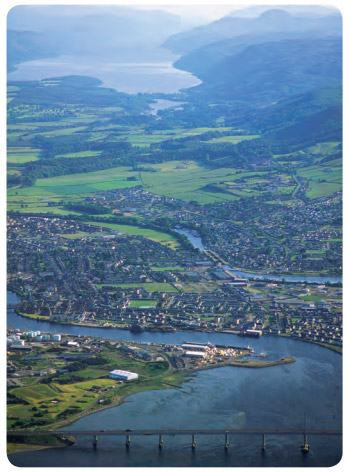
A number of key ports and industrial sites around the Moray and Cromarty Firths - including Ardersier, Nigg, Highland Deephaven, Invergordon and Buckie - are well-placed to take advantage of investment in the energy sector, both in renewables and in oil and gas. The Nigg yard is part of the Low Carbon/Renewables North Enterprise Area. Their development will go hand in hand with continuing protection of the very special environment of the Firths.
We will have vibrant rural areas
2.24 Rural areas support a number of economic sectors, including tourism, food and drink and other primary industries. Growth and investment in these sectors relies on the continuing environmental quality of our countryside, infrastructure and the sustainable use of our natural resources. It is now far easier to access further and higher education in rural Scotland, helping to attract and retain people and investment. In many areas, the knowledge economy is a positive driver for change, stimulating skills and innovation. This extends across the country, from the Dumfries Learning Town initiative and Heriot Watt's Galashiels campus in the south to the University of the Highlands and Islands in the north.
2.25 Increased population growth will be vital to sustain many of our rural communities. Patterns of population change vary across rural Scotland. Between 2002 and 2012 Argyll and Bute experienced a 4.5% fall in population whilst in Aberdeenshire, the Orkney Islands and Highland there was an increase of around 11%. 2010-based household projections for local authorities range from significant growth between 2010 and 2035 in more accessible rural areas such as Aberdeenshire, Perth and Kinross, East and West Lothian and Clackmannanshire, and lower growth in more remote areas including the Western Isles, Dumfries and Galloway and Argyll and Bute. By making higher education, jobs, housing and public transport available in more remote rural areas, we are working to address the continued out-migration of young people from rural areas.
2.26 We do not wish to see development in our rural areas unnecessarily constrained. There will be a continuing need for new housing - we expect more people to live and work in Scotland's rural areas as digital links and opportunities for remote working and new enterprises continue to grow. The Scottish Planning Policy sets out a framework for planning for rural housing which reflects the varying characteristics and pressures of rural communities. It highlights that careful planning is required to manage demand in our most accessible countryside around towns and cities. Remote areas are likely to benefit from a more flexible approach, particularly where it helps to sustain fragile communities. Facilitating the delivery of affordable rural housing remains a priority to support community vitality and increase population growth. Design solutions will ensure that affordability need not be at odds with achieving more ambitious emissions standards.
2.27 Nationally, the Scottish Government will continue to work with the housing sector to identify innovative approaches to rural housing, including assisting rural enablers to support individual house building and, as in all of Scotland, to ensure a sufficient supply of new and affordable housing for both rent and ownership. This is a significant factor in sustaining rural communities, and there are particular housing support mechanisms available in crofting communities.
2.28 Our diverse and vibrant rural towns support clusters of services, have a significant share of homes and jobs, and act as transport hubs for a much wider rural community. We want to see the role of these towns strengthened and diversified. Benefiting from the actions set out in the Town Centre Action Plan, they will also be a focus for increased active travel initiatives and for new technologies, including low carbon and renewable heat and digital connectivity.
2.29 Whilst many regionally and locally important towns will continue to grow and prosper, we also need innovation and vision for our more fragile towns to make the most of their resources and build their resilience. Community ownership of assets and an emphasis on 'local people leading' will help to stimulate further initiatives that revive the fortunes of many of our key towns, villages and rural communities. Our target is for one million acres of land to be community owned by 2020. All over Scotland, 'transition towns' are demonstrating new ideas for alternative, lower carbon ways of living through community-led initiatives. Successful places will be those which attract ideas, investment and people.
A flexible strategy for diverse places - rural towns
2.30 All of our towns are important. To illustrate their diversity, the following section highlights the opportunities arising in just five of our towns in different parts of rural Scotland.
Elgin - a diversifying town
The Elgin 'City for the Future' study noted the town's
important role as a regional leader, providing a good range of
services. Its vision is to stimulate business development,
diversification and innovation. Key initiatives include a 'high
street first' approach to regeneration, innovation in technology
and business, education and health, the visitor economy and arts,
culture and heritage. By 2030, dualling of the A96 will enhance the
connectivity of this part of the country, with Elgin acting as an
important transport hub. Marine renewables could provide
opportunities for economic diversification in the area around
Elgin. Nearby Buckie has potential as an operational and
maintenance base for offshore renewable energy development in the
Moray Firth, and a grid connection will come onshore at Portgordon
and connect to the network at Blackhillock, near Keith.
Fort William - a tourism town
Fort William provides important services to an extensive
rural area. Given the town's location and its role as a gateway to
some of Scotland's most iconic and scenic coastal and mountain
areas, tourism forms a key part of the local economy. Lochaber has
become known as a nationally important centre for outdoor
activities like sailing, climbing and mountain biking, and there
are further opportunities for regeneration and to develop
activities along the Caledonian Canal. Programmed improvements to
the A82 and the scenic routes initiative will support this
further.

Kilmarnock - a changing town
Like many other areas of Scotland, East Ayrshire has
experienced economic challenges in recent years. East Ayrshire's
strategy for growth focuses on the regeneration of Kilmarnock,
including the redevelopment of the former Diageo site, an extensive
area of previously used land in the heart of the town. Kilmarnock
is a strategically important hub for the wider rural area,
supporting jobs and providing services to its surrounding
communities. Its relationship with other towns, including nearby
Ayr, Irvine and Cumnock, requires consideration through a
place-based approach to development. Transport connections from
this area to Glasgow and the wider cities network, and to the
south, will continue to be a priority, as will the development of
the Central Scotland Green Network across Ayrshire.
Galashiels - a connected town
The Central Borders is expected to accommodate a significant
share of the wider area's future housing requirements, and will
continue to be a focus for economic investment and services. The
completion of the Borders Railway will support new, more
sustainable locations for development in the Central Borders, with
Galashiels providing an important transport interchange. There are
opportunities for the town, as in other distinctive towns across
the Borders, to increase footfall in its town centre, including
through diversification of retail facilities. In Hawick, Selkirk
and Galashiels, flood protection measures are a priority to unlock
central sites for development and build future resilience.
Opportunities for district heating serving Galashiels are also
expected.
Dumfries - a gateway town
Dumfries is the regional capital of the south west of
Scotland. Demonstrating the potential of rural towns to make a
unique and significant contribution to the national spatial
strategy, regeneration of the Crichton Quarter and the Learning
Town initiative are providing opportunities for local learning,
skills development and innovation, including in carbon management
and rural development. Tourism, food and drink and primary
industries will continue to be important for Dumfries. A new
hospital will be developed, strengthening the role of Dumfries as
an important service centre. The Solway has significant
opportunities for marine renewable energy generation, which could
help to further diversify the local economy over the long-term.
Wider opportunities for economic growth are also likely to be
located along the A74 corridor. The area has a close relationship
with Carlisle, and connections, including by rail and via the A77
and A75, will continue to be important locally and for
longer-distance links to Ireland, England and Europe.

Regional spatial priorities - South of Scotland
The South of Scotland has a key role to play as a Gateway to
Scotland. In 2013, the 'Borderlands' Report highlighted the
opportunities arising for closer collaborative working between
local authorities in the south of Scotland and north of England.
Building on this, cross-border working is now being explored,
focusing on opportunities for tourism, transport connections and
business development across the region as a whole. Complementing
this, our national spatial strategy aims to facilitate sustainable
rural development across the south of Scotland and highlights the
role of key towns, such as Dumfries, Stranraer and Galashiels as
priority areas for further action and investment. The strategy also
reflects the importance of connections between this area and other
parts of Scotland, the north of England and Northern Ireland.
Coastal and island communities will benefit from new investment
2.31 Our islands and coastal areas contain some of our most vibrant and culturally distinctive communities. Working together with the National Planning Framework, Scotland's first National Marine Plan will provide the strategic policy framework to encourage sustainable development and use of the marine environment to deliver economic and social benefits for island and coastal communities.
2.32 Whilst some of our coastal and island areas are characterised by low density and dispersed development, in particular crofting settlements, there are also towns which act as hubs for services and transport networks and will be a focus for new development. Examples range from Stranraer in the south west where regeneration is ongoing following relocation of the ferry terminal to Cairnryan, to Wick and Thurso in the far north where charrettes have begun to define new visions for these more remote communities.
2.33 Some towns around our coast may be more vulnerable because of the economic downturn and the challenging financial climate for the public sector. Our Town Centre Action Plan highlights what we are doing to support investment and a mix of uses to reinvigorate centres like these. Land reform and the community right to buy can also strengthen relatively remote communities, empowering them to create new futures.

2.34 There are opportunities to develop the existing strengths of many of our coastal and island areas, for example in tourism and in primary industries like food and drink. They have continuing strengths in key sectors including whisky, forestry (notably in Argyll and Dumfries and Galloway), fishing in many ports along the coast and in the islands, and crofting. In the east, existing links with the oil and gas sector, and the growing opportunities in and around the cities network for renewable energy development, have a strong coastal dimension. Land use and marine planning should aim to balance development with environmental quality and activities such as fishing and tourism.
2.35 Seizing new opportunities such as those in the learning economy and the energy sector will help to deliver sustainable economic growth, attracting and retaining population and supporting services. The University of the Highlands and Islands, and other centres of learning and research like the Heriot Watt Campus in Kirkwall, are transforming the further and higher education sector in many of our island and coastal communities.
2.36 Aquaculture is an important aspect of the economy across parts of coastal Scotland, supporting many jobs - often in small communities - and representing a significant element of Scotland's exports. The industry has identified ambitious growth targets which we want to see realised.
2.37 We are working with the oil and gas sector to maintain the competitiveness of the industry and capitalise on skills, experience and existing infrastructure. There will be significant opportunities for increased production from oil and gas reserves in the West of Shetland and northern North Sea, and for decommissioning of existing infrastructure reaching the end of its life. Many of the sites identified in our National Renewables Infrastructure Plan have the potential to benefit from this. Existing assets - like Sullom Voe, the adjacent TOTAL gas plant and the Flotta oil terminal - will continue to play an important economic role.

A flexible strategy for diverse places - coastal and island hubs
2.38 Many coastal and island communities have key towns, where development opportunities, employment, homes and services are often clustered. Place-based development plans for our coastal and island areas should recognise the role of these towns as important focal points for investment and transport connections. To illustrate their diversity, the following section highlights the opportunities arising in just six of our northern and western and northern coastal and island towns.
Stranraer
Stranraer and Cairnryan are Scotland's gateway to Northern
Ireland. Since relocation of the ferry terminal from the centre of
Stranraer, regeneration plans for the waterfront have become of
critical importance to the town and wider region. Local partners
are working together to fulfill their vision for the town as a
marine leisure destination. A masterplan is driving forward
regeneration of the town centre and redevelopment of derelict land
at the former ferry port. Housing renewal and retail initiatives
are helping to reinvigorate the centre of town, and the refurbished
West Pier was reopened in 2013. It is important that the momentum
gained from designating Port Facilities at Loch Ryan as a national
development in
NPF2 is not
lost - following opening of the new facilities in 2011, targeted
interventions are being made to improve the A77 and A75 and a new
electric bus service is providing a low carbon transport link from
the new port facilities to the town centre. The A75 is a Euroroute,
providing a vital link from Northern Ireland across the region to
the rest of Scotland, England and Europe.
Campbeltown
Like a number of other coastal towns in south west Scotland,
research suggests that Campbeltown could be particularly vulnerable
to the economic downturn. However, it also has significant
opportunities for business development and future growth - for
example, Scotland's only facility for the manufacture of wind
turbine towers is located at nearby Machrihanish. The recent
upgrading of Campbeltown Harbour, and emerging plans for offshore
renewables, mean the town is now well-placed to act as a green
energy hub, as reflected in the National Renewables Infrastructure
Plan. Improved access from the Central Belt is underway, including
trunking of the A83. A 3-year summer-only pilot ferry service has
also been introduced between Ardrossan and Campbeltown. The Kintyre
peninsula provides important links to Islay, Gigha and Jura, acting
as a transport hub for much of Argyll. Plans to improve digital and
electricity grid connections will play a key role in supporting
business development.

Oban
Oban is a gateway to the isles and a popular tourism
destination in its own right. The Lorn Arc Initiative aims to make
use of Oban's strategic location by repositioning the town's
economy. Through regeneration and development, the initiative aims
to generate employment across a number of sectors, including
renewable energy, tourism and marine science. The wider area has
significant potential as a focus for innovation and expertise - the
nearby Scottish Association for Marine Science is a key centre for
marine study and there are plans to establish a European Marine
Science Park, whilst Balcardine has been identified as a location
for renewable energy-related business development. Investment in
infrastructure is planned, including the extension of Oban North
Pier and improvements to road infrastructure. Oban is an important
transport interchange with a crucial rail service and connections
by bus and ferry to Argyll and the Inner Hebrides. Oban Airport
will continue to play a role in supporting business activity and
providing essential links to services for wider rural
communities.
Stornoway
Stornoway's strategic location, economic potential and role
as a service centre underline its importance to the Western Isles.
Improved grid connection to the islands will be essential to
realise the area's renewable energy potential. Alongside this, new
energy technologies for the islands are being explored, for example
energy storage, energy efficiency measures and infrastructure for
electric and hydrogen fuelled vehicles. This could not only build
resilience but also help to address disadvantage and higher fuel
costs. Arnish is part of the Low Carbon/Renewables North Enterprise
Area. Stornoway is an important transport hub for passenger and
commercial transport. Stornoway harbour's strategic location means
that it will be well placed as a stopping point for international
shipping with the opening of the North East Passage to navigation.
It also has significant potential as a destination for cruise ships
and leisure craft. The Scottish Government's Step Change Programme
will transform digital connectivity through significant investment
in next generation broadband.

Kirkwall
Kirkwall has an important role to play within the wider area
of co-ordinated action for the Pentland Firth and Orkney Waters.
Ambitious plans for wave and tidal energy, together with the wider
area's importance as a strategic location for shipping and energy
infrastructure, provide significant new opportunities for the town.
Improvements to Hatston pier, identified within the National
Renewables Infrastructure Plan, are helping to position the town at
the forefront of innovation in the energy sector. The Orkney
Islands have enviable opportunities for tourism development,
building on the unique and internationally recognised heritage of
the islands and the quality of the natural environment. Kirkwall is
an important transport hub for accessing many of the other islands.
Improved grid connection will be a vital component in the future
success of Orkney's marine energy sector. As part of this, there
will be opportunities to develop new technologies and approaches to
harness renewable power generation on and around the islands.
Lerwick
Lerwick forms a focus for regeneration and development
activity, provides crucial services and acts as a cultural centre
for the Shetland Islands. Fishing continues to increase its already
significant contribution to the Shetland economy. Tourism and
creative sectors are priorities for growth. The town is an
important transport hub, with the harbour providing inter-island
ferry connections and links to Aberdeen, Orkney and further afield,
and benefiting from continuing growth in the cruise market. Lerwick
has significant potential to support renewable energy development
in the waters off Shetland, as recognised in the National
Renewables Infrastructure Plan. The development of a grid
connection to the mainland will be essential to facilitate this.
Work is underway to construct a major new gas plant adjacent to the
existing Sullom Voe Oil Terminal, and substantial investment has
been committed to improve and refurbish the existing terminal in
preparation for increased flows of oil from west of Shetland.
Opportunities will arise from the decommissioning of existing
offshore oil and gas infrastructure.
Regional spatial priorities - Northern and Western Isles
In July 2013, the Lerwick Declaration affirmed the
Government's commitment to subsidiarity and local decision-making.
As part of this commitment, Scottish Ministers recognise the case
for further empowering our island communities, and have worked with
the island councils of Shetland, Orkney and Eilean Siar, as well as
the mainland Councils with islands, to explore how to give this
practical effect. In line with this, our spatial strategy reflects
the special planning challenges and opportunities for the Northern
and Western Isles, including their potential to lead deployment of
new offshore renewable technologies, scope for other sectors
including tourism and food and drink, and the importance of digital
and transport links to the rest of Scotland.
Contact
Email: Dr Fiona Simpson
There is a problem
Thanks for your feedback